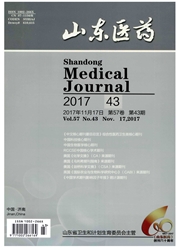

 中文摘要:
中文摘要:
目的 探讨人重组粒细胞集落刺激因子(rhG-CSF)经鼻靶向中枢给药对脑梗死大鼠内源性神经干细胞增殖与迁移的调节作用。方法线栓法制作大脑中动脉阻塞模型(MCAO),皮下或鼻腔给予rhG-CSF(60μg/kg)。运用5-溴脱氧尿苷嘧啶(BrdU)标记及免疫组织化学法检测局灶性脑梗死大鼠室管膜及脑室下层(SVZ)神经干细胞的增殖。结果正常组及假手术对照组大鼠SVZ区域散在少量BrdU阳性细胞;术后7d和14d,脑梗死组大鼠SVZ区BrdU阳性细胞数明显增加;rhG-CSF组BrdU阳性细胞数进一步增加;经鼻给药组的BrdU阳性细胞数明显高于相应时间点的皮下用药组(P〈0.01)。结论rhG-CSF鼻腔给药可以促进脑梗死后大鼠内源性神经干细胞的增殖和靶向迁移。
 英文摘要:
英文摘要:
Objective To investigate the proliferation and transference of endogenous neural stem cells (NSCs) in subependymal and subventricular zone (SVZ) in cerebral infarct (CI) rats given rhG-CSF intranasally. Methods Middle cerebral artery occlusion (MCAO) animal model was established by nylon strand, followed by reperfusion 2 hours later. rhG-CSF was used via subcutaneous or intranasal pathway. Rats were sacrificed at the 7th and 14th day after MCAO. Bromodeoxyuridine (BrdU) labeling method and immunohistochemical staining was used to identify the proliferation of neuronal stem cells. The processes of transference of NSCs in SVZ were observed under light microscope, and the data was analyzed statistically. Results Few BrdU cells had survived in SVZ in normal and sham group. The number of BrdU cells obviously increased after MCAO, up-regulated further after given rhG-CSF, and intranasal group 〉 subcutaneous group 〉 MCAO group (P 〈 0.01 ). Conclusion rhG-CSF given intranasally stimulates the proliferation of endogenous NSCs in SVZ in CI rats. And the proliferative cells trend to migrate from the proliferative zone to the target area.
 同期刊论文项目
同期刊论文项目
 同项目期刊论文
同项目期刊论文
 期刊信息
期刊信息
